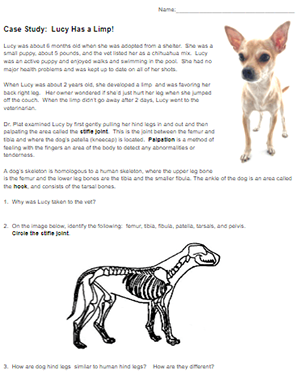
My students always seem enthusiastic when a project includes dogs. Even kids that are normally shy seem willing to open up and share stories of a beloved pet. Most students also have some experience with dogs having health problems. In this case study, the explore how a change in DNA can lead to a specific health problem: patellar luxation.
Patellar luxation is a common problem in chihuahuas and other toy breeds. Dogs with this condition usually present with a limp. Examination reveals that the patella (kneecap) has shifted out of position. Normally, ligaments hold the bone in place within a groove of the femur. In grade 1 PL cases, a veterinarian can manually move the patella back into position. In grades 2-4, the patella will continue to shift out of position and may require surgery.
The case study begins with story of Lucy, the chihuahua and a visit to the vet because she has a limp. Students read background information about the skeletal system of a dog and compare it to a human. The knee joint in dogs is called the stifle, and it has the same basic anatomy as a human knee joint (tibia, fibula, femur, and patella.)
🐕A Genetic Cause?

In the next section of the case, students explore data taken from a published journal article from Vet World. In this study, researchers link patellar luxation to genetics, specifically identifying SNPs, or single nucleotide polymorphisms. The original study includes multiple sources of data. Because I didn’t want to overwhelm students, I have them only look at a section of DNA to identify the SNP.
Students also learn about how SNP’s are named: example: 9175C>G indicates that a G was substituted for a C at position 9175. Students will also need to have a basic understanding of the central dogma. They will need to be able to link the change in nucleotide to a change in protein. Then they will need to explain how a change in protein might lead to patellar luxation.
Overall, this is an activity that can bridge anatomy studies to genetic ones. I have it in my “anatomy” unit, which also includes a rat dissection. AP Biology students usually do this unit toward the end of the year and it includes a dissection of a rat. A dog skeleton model is also really useful for showing students where the patella is on a dog. You can buy cheap plastic dog skeletons around Halloween. They may not be perfect, but you can also ask them to evaluate the accuracy of the model.

